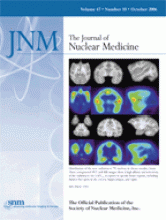TO THE EDITOR: We read with great interest the case report of Koopmans et al. (1) concerning the occurrence of a carcinoid crisis after injection of 6-fluoro-(18F)-dihydroxyphenylanine (18F-DOPA) in a patient referred for 18F-DOPA PET of a metastatic carcinoid. We have been using 18F-DOPA for 4 y and have performed 170 18F-DOPA PET examinations for the detection of neuroendocrine tumors, the majority being carcinoid tumors. No similar cases were observed in our PET center. A single, minor adverse effect was reported by a few patients: a light and transient burning sensation at the injection site, probably due to the acidity of the radiopharmaceutical (pH 4.5–5, controlled before each administration).
Apart from a special sensitivity of this precise patient of Koopmans et al. (1) to 18F-DOPA, what factors might explain the lack of any detectable agonist effect or of any induction of a carcinoid crisis in our patients, in particular those referred because of a carcinoid tumor?
One hour before 18F-DOPA injection, the reported patient received 150 mg of carbidopa orally to block the aromatic amino acid decarboxylase enzyme. We have not used oral premedication with the decarboxylase inhibitor carbidopa. Published studies suggest that its use before PET is far less common for neuroendocrine tumors than for brain imaging. It is nevertheless unlikely that carbidopa may have favored a carcinoid crisis, because it blocks the metabolism of 18F-DOPA into active amines.
In the reported patient, 8 mL of 18F-DOPA solution were administered intravenously in a few seconds. We never use direct intravenous administration of PET radiopharmaceuticals but always inject in an infusion tube connected to saline to minimize the risk of paravenous deposition, which would lead to a large local radiation dose. Furthermore, we inject the 18F-DOPA, in a similar volume of around 8 mL, slowly over 1 min to diminish the burning sensation at the injection site experienced by some patients.
One important parameter to consider is the difference in specific activity between the 18F-DOPA preparations. In the case report, its value was 6 GBq/mmol, whereas for IASOdopa (Iason), the preparation that we use, its value must be at least 30 GBq/mmol at calibration—that is, 5-fold greater. F2-18F gas used for the electrophilic reaction can be obtained either by bombardment of neon with deuterons or by bombardment of 18O-gas with protons. The producer of IASOdopa uses the 18O-gas bombardment method, which ensures much more efficient yields and results in a higher specific activity for 18F-DOPA. However, we inject 5 MBq/kg of body weight—that is, 350 MBq of 18F-DOPA for a 70-kg adult patient—on average 4 h after the calibration time, resulting in a mass of DOPA as carrier that is of the same order of magnitude as that injected in the reported patient.
In conclusion, we testify that 18F-DOPA PET with a slow injection of the radiopharmaceutical through an infusion catheter was safe in 170 cases of endocrine tumors. The presence of DOPA as a carrier in the injection should be kept in mind, and it seems important to use a preparation with a high specific activity, particularly when injections are to be given to patients several hours after preparation. However, the amount of carrier was not greater in the patient reported by Koopmans et al. (1) than in our patients.
References
- 1.↵







